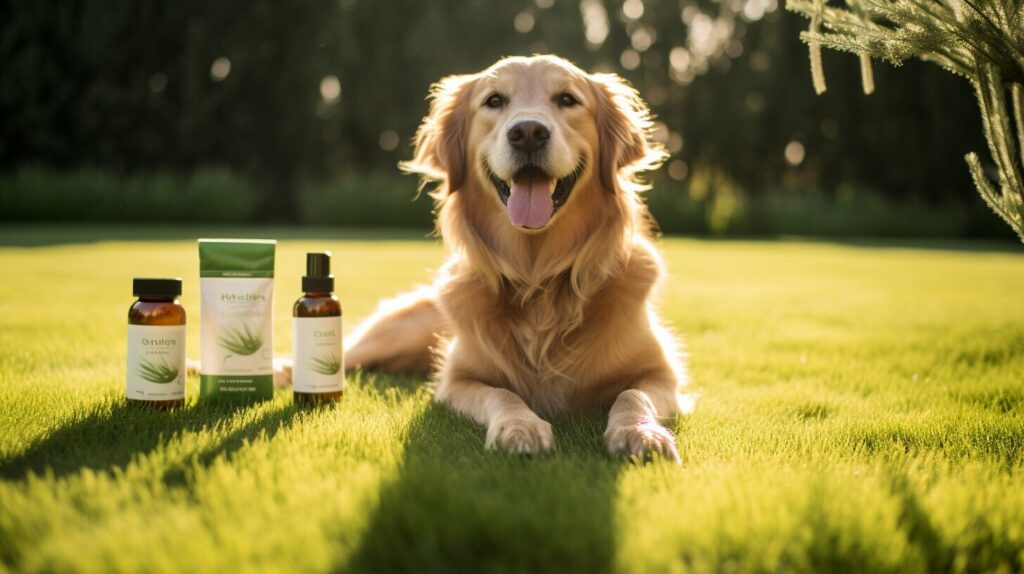As a responsible dog owner, it’s essential to be aware of the potential risks that your furry friend might face in their daily life. Bee stings are one of those risks that can cause discomfort, pain, and even serious health issues if not treated promptly.
It’s crucial to understand the symptoms of a bee sting in dogs, how to treat them, and most importantly, how to prevent them from happening. In this article, we’ll discuss everything you need to know about bee sting dogs, from recognizing the symptoms to seeking veterinary care.
Key Takeaways:
- Bee stings in dogs can cause discomfort, pain, and even severe health problems.
- It’s essential to recognize the symptoms of a bee sting in dogs and take immediate action.
- Preventing bee stings is crucial, and there are strategies to minimize the risk of your dog getting stung.
- Home remedies can help alleviate symptoms, but seeking veterinary care is necessary in severe cases.
- Bee sting awareness is critical for responsible pet ownership.
Recognizing Bee Sting Symptoms in Dogs
As a responsible dog owner, it is crucial to be aware of the signs and symptoms of bee stings in dogs. Your dog can’t communicate with words, so it’s essential to pay attention to their behavior to catch any potential issues early on. Some of the most common symptoms of bee stings in dogs include:
- Swelling in the affected area
- Redness and pain
- Itching and discomfort
- Vocalization or whimpering
- Pawing at the face or the place they were stung
It’s essential to keep an eye on your dog after they have been stung by a bee. In some cases, the symptoms can escalate quickly and potentially cause severe allergic reactions that require emergency medical attention. Keep in mind that dogs may show different signs of discomfort than humans.
Signs Your Dog May Have Been Stung by a Bee
Some dogs may display more severe symptoms after being stung by a bee. These can include:
- Hives or welts on the skin
- Difficulty breathing
- Vomiting or diarrhea
- Swelling around the muzzle or face
- Disorientation or wobbly gait
- Loss of consciousness
In cases where your dog displays any of these severe symptoms, it’s essential to seek veterinary care as soon as possible.
Treating Bee Stings in Dogs: First Aid and Remedies
If your dog gets stung by a bee, it’s essential to take immediate action to minimize discomfort and prevent potential complications. Here are the steps you should take:
| Step | Description |
|---|---|
| Step 1 | Remove the stinger |
| Step 2 | Clean the affected area |
| Step 3 | Apply a cold compress |
If your dog experiences severe or persistent symptoms, contact a veterinarian immediately. Some common over-the-counter remedies for bee stings include:
- Benadryl
- Hydrocortisone cream
- Baking soda paste
Natural remedies such as chamomile tea and aloe vera can also help soothe the affected area.
However, never administer any medication or remedy without first consulting with a veterinarian. In some cases, additional treatment or medication may be necessary, especially if your dog shows signs of an allergic reaction. It’s crucial to have an emergency dog bee sting first aid kit on hand and be prepared to use it if needed.
Allergic Reactions to Bee Stings in Dogs
While most dogs will experience a mild reaction to a bee sting, some may have an allergic reaction, which can be life-threatening. It is essential to recognize the signs of an allergic reaction and seek veterinary care immediately.
Common signs of an allergic reaction include facial swelling, difficulty breathing, vomiting, diarrhea, and collapse. In severe cases, the dog may go into anaphylactic shock, which requires immediate treatment.
If you suspect your dog is having an allergic reaction to a bee sting, seek veterinary care immediately. Time is of the essence in such cases, and prompt treatment can save your dog’s life. The veterinarian may administer epinephrine, steroids, or antihistamines to alleviate the symptoms.
If your dog has a known allergy to bee stings, talk to your veterinarian about a management plan. They may recommend allergy testing and desensitization therapy to decrease the dog’s sensitivity to bee venom.
It is crucial to monitor your dog closely when in areas where bees are present and take necessary precautions to prevent bee stings. Being aware of the potential risks and having a plan of action in case of an emergency can help ensure your dog’s safety and well-being.
Preventing Bee Stings in Dogs: Tips and Precautions
Bee stings can be painful and even dangerous for dogs. However, there are ways to minimize the risk of your furry friend getting stung. By taking the following precautions, you can help protect your dog from bee stings:
- Keep your dog on a leash when outdoors, especially in areas where bees are known to be present.
- Avoid letting your dog sniff around flowers or plants that attract bees.
- Provide a safe and secure outdoor environment for your dog, such as a fenced backyard.
- Keep garbage cans and compost bins securely covered to avoid attracting bees.
- Train your dog to stay away from bees and not to try to catch them.
- Be aware of your dog’s surroundings and avoid walking near beehives or nests.
- If you know your dog has a history of bee stings or an allergy, talk to your veterinarian about the best ways to prevent future incidents.
By taking these simple steps, you can help prevent your dog from getting stung by bees and reduce the risk of potential complications. Remember to always be vigilant and aware of your dog’s behavior when outdoors to ensure their safety and well-being.
Home Remedies for Bee Stings on Dogs
Watching your beloved dog experience a bee sting can be a stressful experience. While seeking veterinary care is always the best option, there are some home remedies you can try to soothe your dog’s symptoms. Remember to consult with your veterinarian before trying any of these remedies to ensure they are safe for your dog.
Baking Soda Paste
Baking soda is a common home remedy for bee stings in humans and can also be used on dogs. Mix baking soda and water to create a paste, and apply it to the affected area. Leave the paste on for around 15 minutes before rinsing it off with water.
Cold Compresses
Applying a cold compress to the sting can help reduce swelling and relieve pain. Wet a towel with cold water and apply it to the affected area for 10 to 15 minutes. Repeat the process every few hours as needed.
Herbal Remedies
Some herbal remedies can also help relieve the symptoms of a bee sting on a dog. Chamomile tea bags soaked in cold water can be applied to the affected area to reduce swelling and pain. Aloe vera gel can also be applied to the sting to soothe the skin.
Remember, these home remedies are meant to be used as a first aid measure and are not a substitute for professional veterinary care. If your dog is experiencing severe or persistent symptoms, contact your veterinarian immediately.
Seeking Veterinary Care for Bee Stings in Dogs
If your dog experiences severe or persistent symptoms after being stung by a bee, it is important to seek veterinary care immediately. This is especially true if your dog has a known allergy to bee stings or has difficulty breathing, as these can be signs of anaphylaxis, a severe allergic reaction that requires immediate treatment.
When you take your dog to the veterinarian for bee sting treatment, they will assess the severity of the sting and recommend an appropriate course of action. Depending on the symptoms, your dog may be given medication, such as antihistamines or anti-inflammatory drugs, to help alleviate the pain and swelling. In some cases, your veterinarian may also recommend a course of steroids to help reduce inflammation.
| Signs that your dog needs veterinary care for a bee sting: |
|---|
| Difficulty breathing |
| Swelling in the throat or face |
| Vomiting or diarrhea |
| Signs of anaphylaxis |
It is important to follow your veterinarian’s instructions carefully, including any medication or treatment recommendations. If you notice any new or worsening symptoms after treatment, contact your veterinarian immediately. This can help ensure that your dog receives the best possible care and recovers from the bee sting as quickly as possible.
Tips for Dealing with Bee Stings in Dogs
If your dog gets stung by a bee, it’s important to act quickly and appropriately to minimize any discomfort or potential health issues. Here are some tips to help you deal with bee stings in dogs:
- Keep the dog calm: A dog that’s agitated or anxious may worsen the effects of the bee sting. Try to keep your dog calm, and offer reassurance and comfort.
- Avoid further exposure to bees: If your dog has been stung by a bee, it’s best to keep them away from any bees or bee-attracting areas to prevent further stings or reactions.
- Monitor for adverse reactions: Even if your dog seems fine after being stung, watch for any signs of an adverse reaction, such as vomiting, diarrhea, difficulty breathing, or excessive swelling. Contact your veterinarian immediately if you see any concerning symptoms.
It’s also important to have a dog bee sting remedy on hand in case of an emergency. Consult with your veterinarian to determine the best medication or treatment for your dog’s needs. By being prepared, aware, and proactive, you can help keep your furry friend safe and healthy in the face of bee stings.
The Importance of Bee Sting Awareness for Dog Owners
As a dog owner, it’s important to be aware of the potential risks associated with bee stings. A bee sting can cause discomfort and pain for your furry friend, but in some cases, it can also lead to severe allergic reactions that could be life-threatening.
The first step towards bee sting awareness is to understand the symptoms and signs of a bee sting in dogs. Common symptoms include redness, swelling, pain, and itching around the affected area. Your dog may also show signs of distress, such as whimpering, licking, or scratching the affected area. In severe cases, your dog may show symptoms of anaphylaxis, such as difficulty breathing, pale gums, or collapse.
Preventing bee stings in dogs is another critical aspect of bee sting awareness. Some simple precautions can go a long way in minimizing the risk of your dog getting stung. For example, keep your dog on a leash when outdoors, avoid areas with bees, and provide a secure outdoor environment for your furry friend. Proper training and awareness can also help minimize the risk of bee stings.
If your dog does get stung, it’s important to take immediate action to alleviate their discomfort and prevent further complications. In many cases, home remedies such as cold compresses, baking soda paste, or herbal remedies can help alleviate symptoms. However, if your dog shows signs of severe or persistent symptoms, it’s critical to seek veterinary care as soon as possible.
Overall, bee sting awareness is an essential aspect of responsible dog ownership. By being informed and taking necessary precautions, you can help protect your furry friend from the potential risks associated with bee stings. Remember, prevention is key, but if your dog does get stung, staying calm and taking immediate action can help ensure a positive outcome.
Section 10: Conclusion
As a responsible dog owner, it is crucial to be aware of the risks associated with bee stings and take necessary precautions to keep your furry friend safe. By understanding the symptoms, treatment options, and prevention methods discussed in this article, you can be better prepared to respond to a bee sting incident if and when it occurs.
Remember to keep a close eye on your dog and observe any signs of discomfort or distress, especially during the warmer months when bees are more active. If your dog does get stung, follow the first aid and home remedies discussed, and seek veterinary care if necessary.
Overall, by being informed and taking necessary measures to prevent bee stings, you can help ensure your dog’s health and well-being, and enjoy a worry-free time outdoors together.
FAQ
Q: What are the common symptoms of a bee sting in dogs?
A: Common symptoms of a bee sting in dogs include swelling, redness, pain, and itching. The dog’s behavior may also change if they are experiencing discomfort.
Q: How should I treat a bee sting on my dog?
A: If your dog gets stung by a bee, you should first remove the stinger, clean the affected area, and apply cold compresses. Over-the-counter remedies and natural remedies can also help alleviate symptoms. If the symptoms are severe or persistent, contact a veterinarian.
Q: Can dogs have allergic reactions to bee stings?
A: Yes, dogs can have allergic reactions to bee stings. It is important to be able to identify the signs of an allergic reaction, such as difficulty breathing or swelling of the face or throat. Seek immediate veterinary care in such cases.
Q: How can I prevent bee stings in my dog?
A: To minimize the risk of bee stings in dogs, you can avoid bee-attracting areas, keep your dog on a leash, and provide a safe outdoor environment. Proper training and awareness are also important for both dogs and owners.
Q: Are there any home remedies for bee stings on dogs?
A: There are natural remedies and home treatments that can help soothe a bee sting on a dog, such as baking soda paste, cold compresses, and herbal remedies. However, it is advisable to consult with a veterinarian before trying any home remedy.
Q: When should I seek veterinary care for bee stings in my dog?
A: It is important to seek veterinary care for bee stings, especially if the symptoms are severe, the dog has a known allergy, or the stinger cannot be removed. A veterinarian may recommend medication, anti-inflammatory drugs, or antihistamines.
Q: Any additional tips for dealing with bee stings in dogs?
A: It is important to keep the dog calm, avoid further exposure to bees, and monitor for any adverse reactions after the initial sting. Being prepared and knowledgeable can help respond effectively in such situations.
Q: Why is bee sting awareness important for dog owners?
A: Bee sting awareness is crucial for dog owners to prevent potential incidents and minimize the impact of a sting on their dog’s health and well-being. Responsible pet ownership includes being informed about the risks associated with bee stings.



